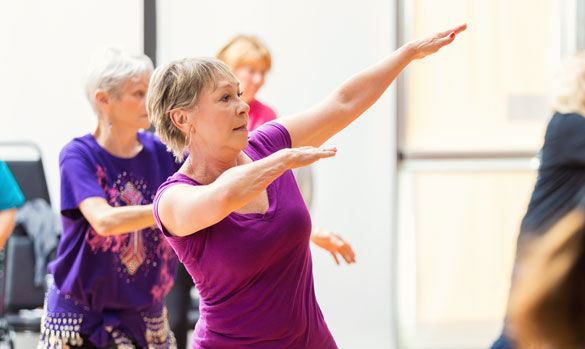
Older adults are among the least physically active of any age group, putting them at increased peril for developing chronic diseases and other health risks (U.S. Department of Health and Human Services, 2000).Couple this with reduced function, decreased muscular strength and endurance, and an increased risk for falls, and it quickly becomes apparent that remaining active and preserving as much health and physical fitness as possible should be of paramount concern as people age. For many middle-aged and older adults, exercise is not only a means to better fitness and health, but also a path to maintain or even regain independence.
Enjoyment of an activity is a key element of becoming—and staying—motivated to participate, and that is where Zumba Gold® comes in. Zumba®, a dance exercise class that features Latin and World rhythms, is currently one the most popular group-based exercise classes in the world, with an estimated 12 million people of all shapes and sizes participating in Zumba classes on a weekly basis (Luettgen et al., 2012). Zumba Gold is a lower-intensity version of the typical Zumba class and was designed to meet the anatomical, physiological and psychological needs of seniors. Perhaps Zumba Gold will provide a suitable option for older adults seeking alternative means of reaching their exercise goals.
According to its website (www.zumba.com), Zumba provides “a total workout, combining all elements of fitness—cardio, muscle conditioning, balance and flexibility, boosted energy and a serious does of awesome.” While testing Zumba’s awesomeness may be tough, ACE sought to assess the cardiovascular and metabolic responses to Zumba Gold and to determine if the class meets current guidelines for improving and maintaining cardiorespiratory fitness.
ACE enlisted the help of Lance C. Dalleck, Ph.D., and his team of researchers in the High Altitude Exercise Physiology Program at Western State Colorado University to test whether Zumba Gold is a good exercise option for middle-aged and older adults.
The Study
Sixteen men and women, ranging in age from 40 to 85, participated in this study, all of whom were considered low-to-moderate risk and free of any cardiovascular, pulmonary or metabolic disease. The study was done over two non-consecutive days. On day 1, the research team collected each participant’s physical and physiological measures (Table 1).
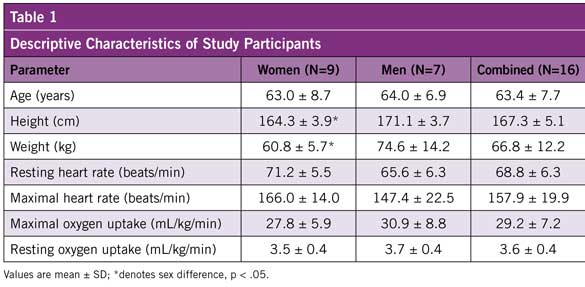
On day 2, the participants took part in a 45-minute Zumba Gold exercise class, during which the researchers tracked their cardiovascular and metabolic responses to the activity using a portable calorimetric measurement system and heart-rate monitor.
Remember, the objective of this research was to determine whether Zumba Gold meets current guidelines for improving and maintaining cardiorespiratory fitness. Those guidelines include performing aerobic exercise for 20 to 60 minutes three to five days per week at an intensity of 40/50 to 85% of heart-rate reserve (HRR) or oxygen uptake reserve (VO2R) (Garber et al., 2011). In addition, current guidelines recommend a target energy expenditure of 150 to 400 kilocalories per day [American College of Sports Medicine (ACSM), 2014].
In both the U.S. Surgeon General report on physical activity (U.S. Department of Health and Human Services, 1996) and elsewhere (Ainsworth et al., 2011), moderate-intensity physical activity in metabolic terms has been classified as 3 to 6 metabolic equivalents (METs).
The Results
The cardiovascular and metabolic responses to the Zumba Gold class are presented in Table 2. Key findings include an overall heart rate of 114.3 ± 14.2 beats/minute, which is equivalent to 50.1 ± 10.1 percent of HRR and 49.6 ± 8.4 percent of VO2R. These values fall toward the low end of the recommended intensity ranges for improving cardiorespiratory fitness, but reflect a moderate exercise intensity that should be suitable for most older adults.
The total energy expenditure was 197.9 ± 38.0 kcal/session and the absolute exercise intensity was 4.3 ± 0.4 metabolic equivalents (METs). Both of these values fall within the ranges recommended for health benefits (U.S. Department of Health and Human Services, 1996).
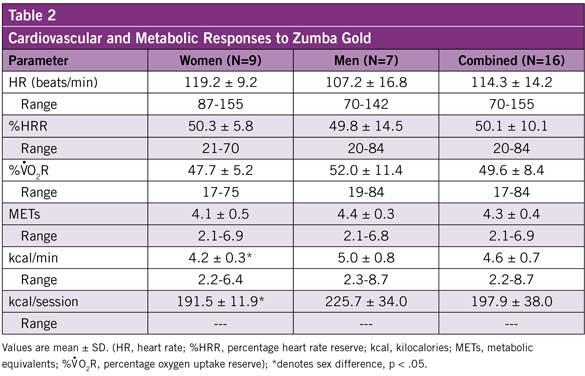
The researchers found there to be significant differences between the sexes when it came to calories burned per minute and over the course of the full Zumba Gold session. These differences are likely explained by the fact that the men were substantially heavier than the women.
Figure 1 illustrates the exercise intensity for a representative participant throughout the duration of the class.
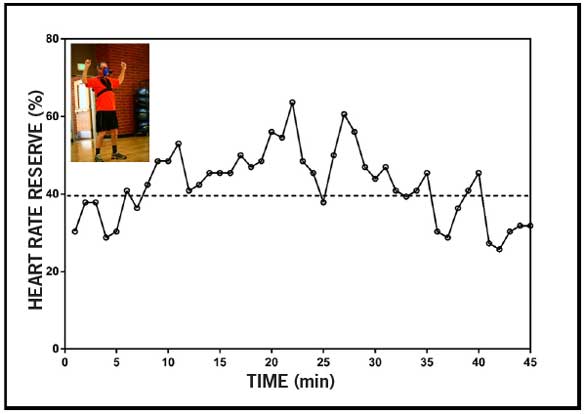
Figure 1 – Exercise intensity in terms of heart-rate reserve (HRR) for a representative participant throughout the duration of the Zumba Gold exercise class. The horizontal line denotes the minimal exercise intensity recommendation (40% HRR) for improving and maintaining cardiorespiratory fitness.
The Bottom Line
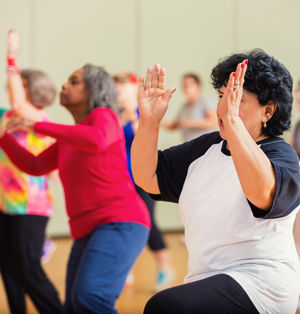 The main finding of this research is that participation in a single exercise class of Zumba Gold by middle-aged and older adults elicits cardiovascular and metabolic responses that fulfill exercise intensity guidelines for improving and maintaining cardiorespiratory fitness (ACSM, 2014; ACE, 2014).
The main finding of this research is that participation in a single exercise class of Zumba Gold by middle-aged and older adults elicits cardiovascular and metabolic responses that fulfill exercise intensity guidelines for improving and maintaining cardiorespiratory fitness (ACSM, 2014; ACE, 2014).
“These finding establish Zumba Gold as an ideal alternative exercise modality for middle-aged and older adults,” says Dr. Dalleck.
Moderate-intensity exercise can be defined as falling within a range of 40 to 59% of HRR or VO2R (ACSM, 2014). The participants in this study averaged a workload of 50.1% of HRR and 49.6% of VO2R, both of which fall within this range.
However, Dr. Dalleck offers the following word of caution: “While the mean response was in the moderate range, there were instances where some individuals reached the vigorous-intensity threshold.” While Zumba Gold is gentle enough for most older adults, he says, “some individuals experienced greater cardiorespiratory strain.”
If those individuals are among those at a higher risk for exercise-related events such as a heart attack or sudden death, the exercise intensity during the peak portion of class could become an issue.
“Statistically speaking,” says Dr. Dalleck, “more people are going to be moderate or high risk than will be low risk, so fitness professionals should be mindful and use caution when recommending Zumba Gold for higher-risk individuals, such as those with cardiac disease or type 2 diabetes.”
Dr. Dalleck also points out that in many fitness facilities, the screening of group exercise participants can be somewhat hit or miss. For this reason, enhanced screening of potential Zumba Gold participants may be called for.
One element of the Zumba Gold class not reflected in the numbers is the fun and socializing that takes place. Dr. Dalleck reports that the participants in this study really enjoyed the experience, and that can be the key to overcoming a tremendous obstacle to regular physical-activity participation for many people. Finding an exercise modality one enjoys can be difficult, and Zumba Gold may just be the answer for which you and your clients have been looking.
References
Ainsworth, B.E. et al. (2011). Compendium of physical activities: A second update of codes and MET values. Medicine & Science in Sports & Exercise, 43, 8, 1575-1581.
American College of Sports Medicine (2014). ACSM's Guidelines for Exercise Testing and Prescription (9th ed.). Philadelphia: Wolters Kluwer/Lippincott Williams & Wilkins.
American Council on Exercise (2014). ACE Personal Trainer Manual (5th ed.). San Diego: American Council on Exercise.
Garber, C.E. et al. (2011). Quantity and quality of exercise for developing and maintaining cardiorespiratory, musculoskeletal, and neuromotor fitness in apparently healthy adults: Guidance for prescribing exercise Medicine & Science in Sports & Exercise, 43, 7, 1334-1359.
Luettgen, M. et al. (2012). Zumba®: Is the "fitness-party" a good workout? Journal of Sports Science and Medicine, 11, 2, 357-358.
U.S. Department of Health & Human Services (2000). Healthy People 2010: Understanding and Improving Health (2nd ed.) Washington, D.C.: U.S. Government Printing Office.
U.S. Department of Health & Human Services (1996). Surgeon General’s Report: Physical Activity and Health. Washington, D.C.: U.S. Department of Health and Human Services.
Further Your Knowledge

If you’re interested in learning more about developing fitness programs for older adults, you might consider becoming an ACE Senior Fitness Specialist.
This program was designed for health and fitness professionals who want to help people over the age of 55 increase their longevity and boost their quality of life by delivering appropriate exercise programs that combat the effects of osteoporosis, arthritis and other age-specific conditions.
ACE Senior Fitness Specialist [Specialtist Program]
Why Does ACE Sponsor Fitness-related Research Studies?
This study was sponsored by the American Council on Exercise. For more than 20 years, ACE has commissioned independent research studies from major universities and trusted partners across the country, covering everything from infomercial fitness products to the effectiveness of some of the hottest trends in health and fitness. ACE is committed to investing in these studies as part of its mission to promote the benefits of physical activity and to protect people from unsafe and ineffective fitness products and trends. You can find more information about past ACE-sponsored studies, including research on the best abdominal exercises, kettlebell workouts and Zumba, by clicking here.





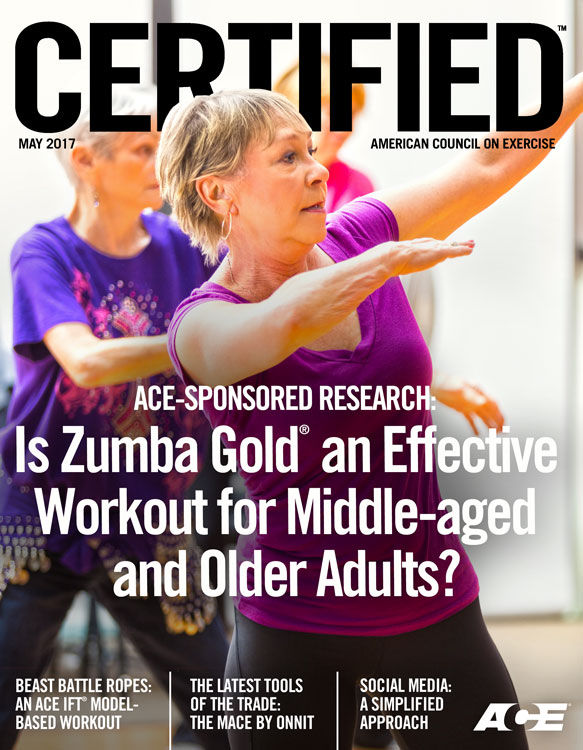





 The main finding of this research is that participation in a single exercise class of Zumba Gold by middle-aged and older adults elicits cardiovascular and metabolic responses that fulfill exercise intensity guidelines for improving and maintaining cardiorespiratory fitness (ACSM, 2014; ACE, 2014).
The main finding of this research is that participation in a single exercise class of Zumba Gold by middle-aged and older adults elicits cardiovascular and metabolic responses that fulfill exercise intensity guidelines for improving and maintaining cardiorespiratory fitness (ACSM, 2014; ACE, 2014).

